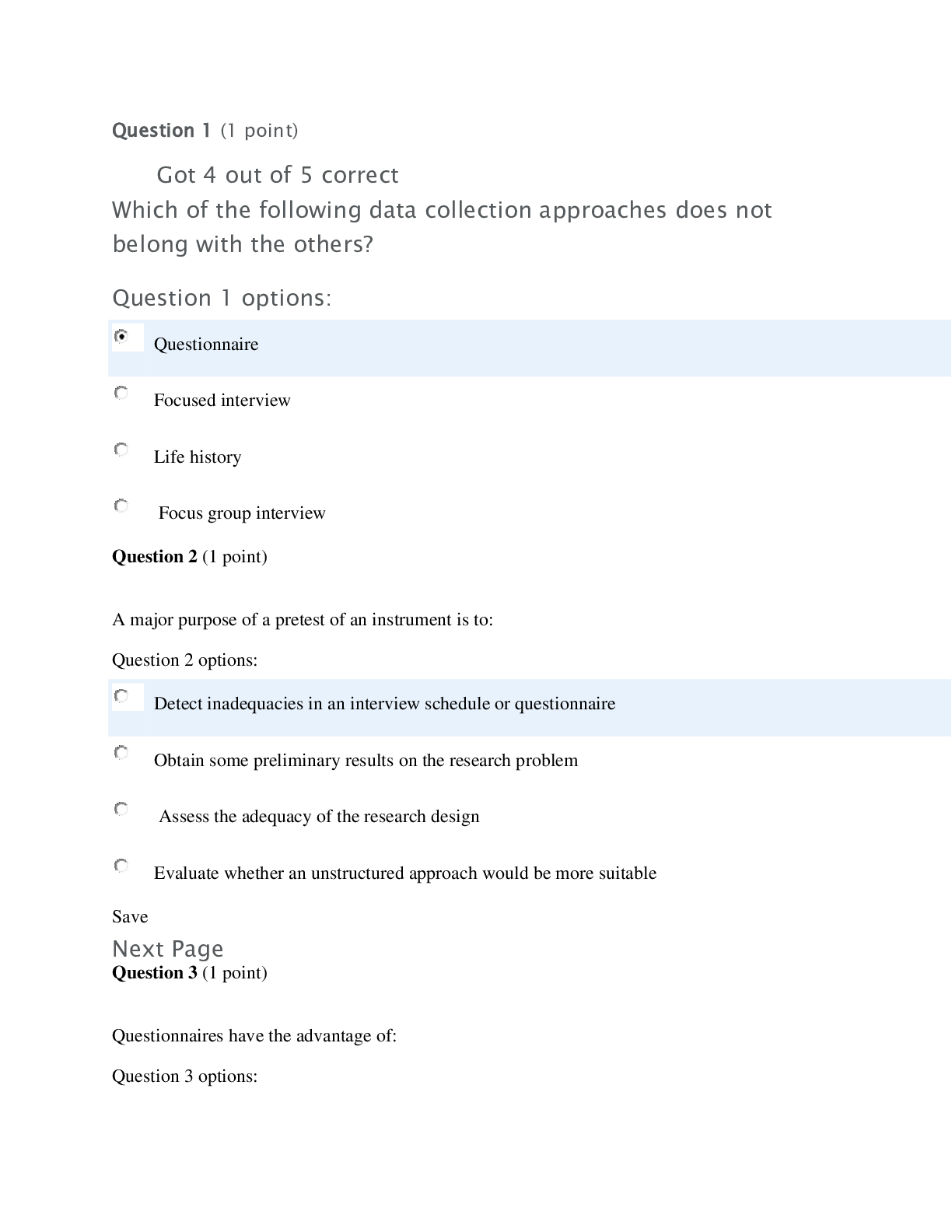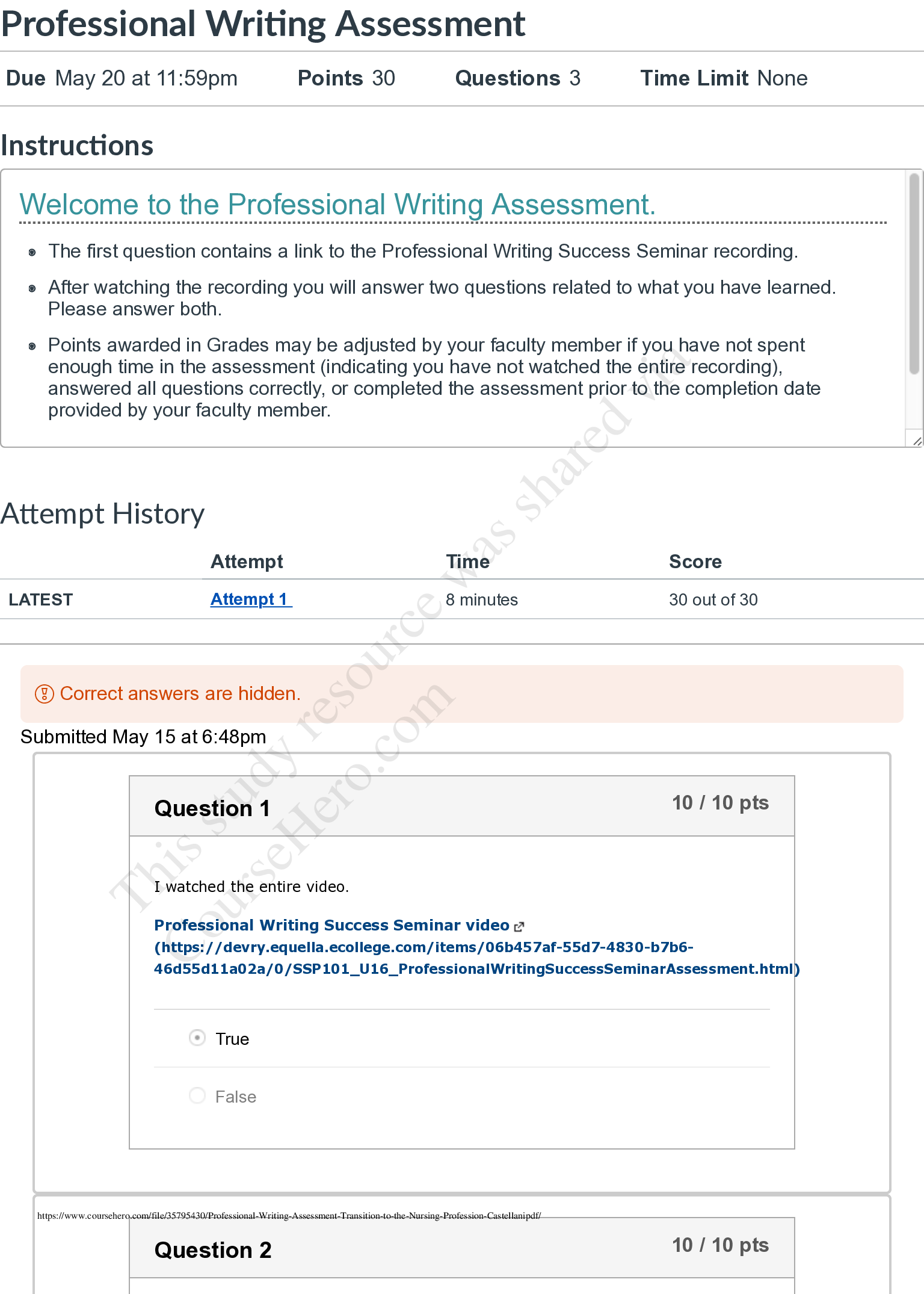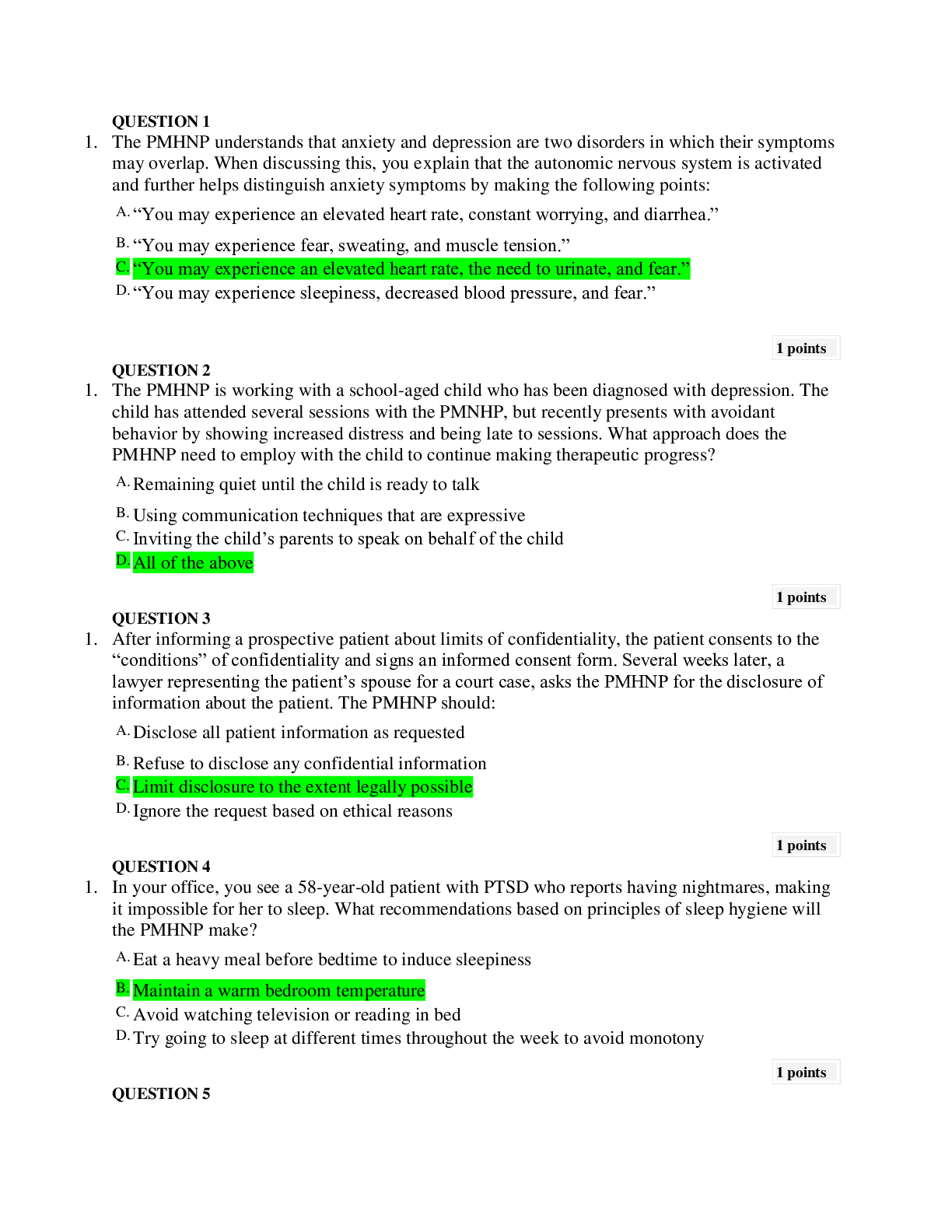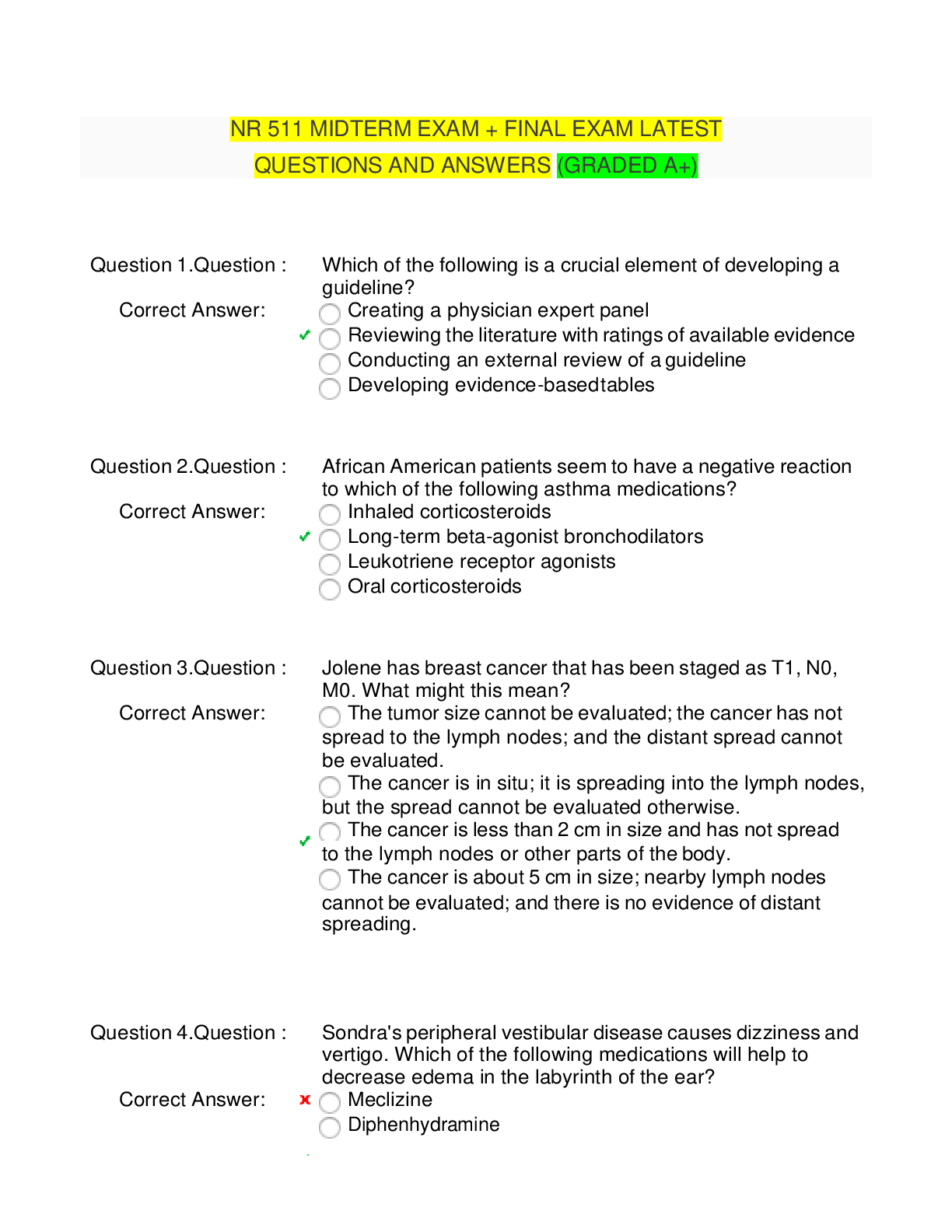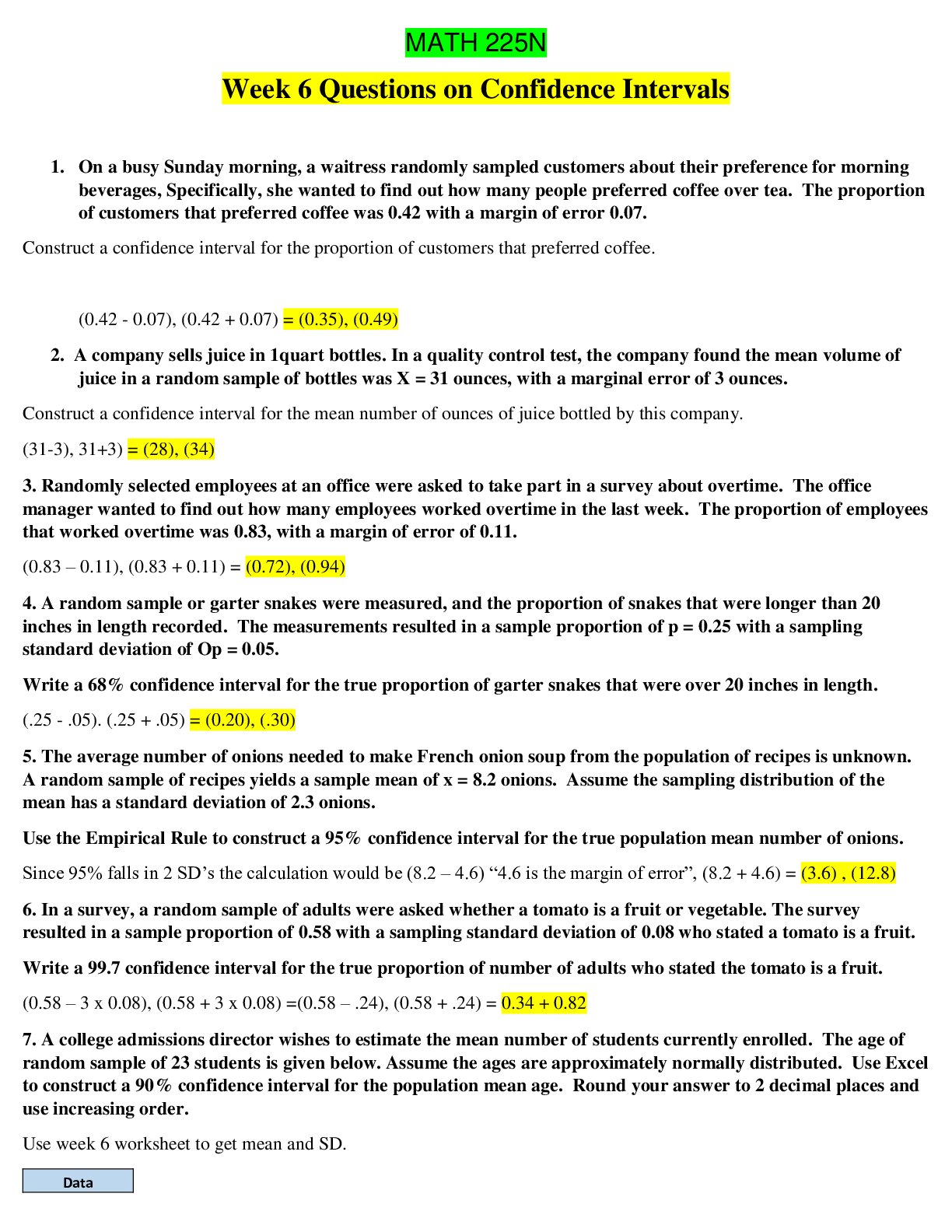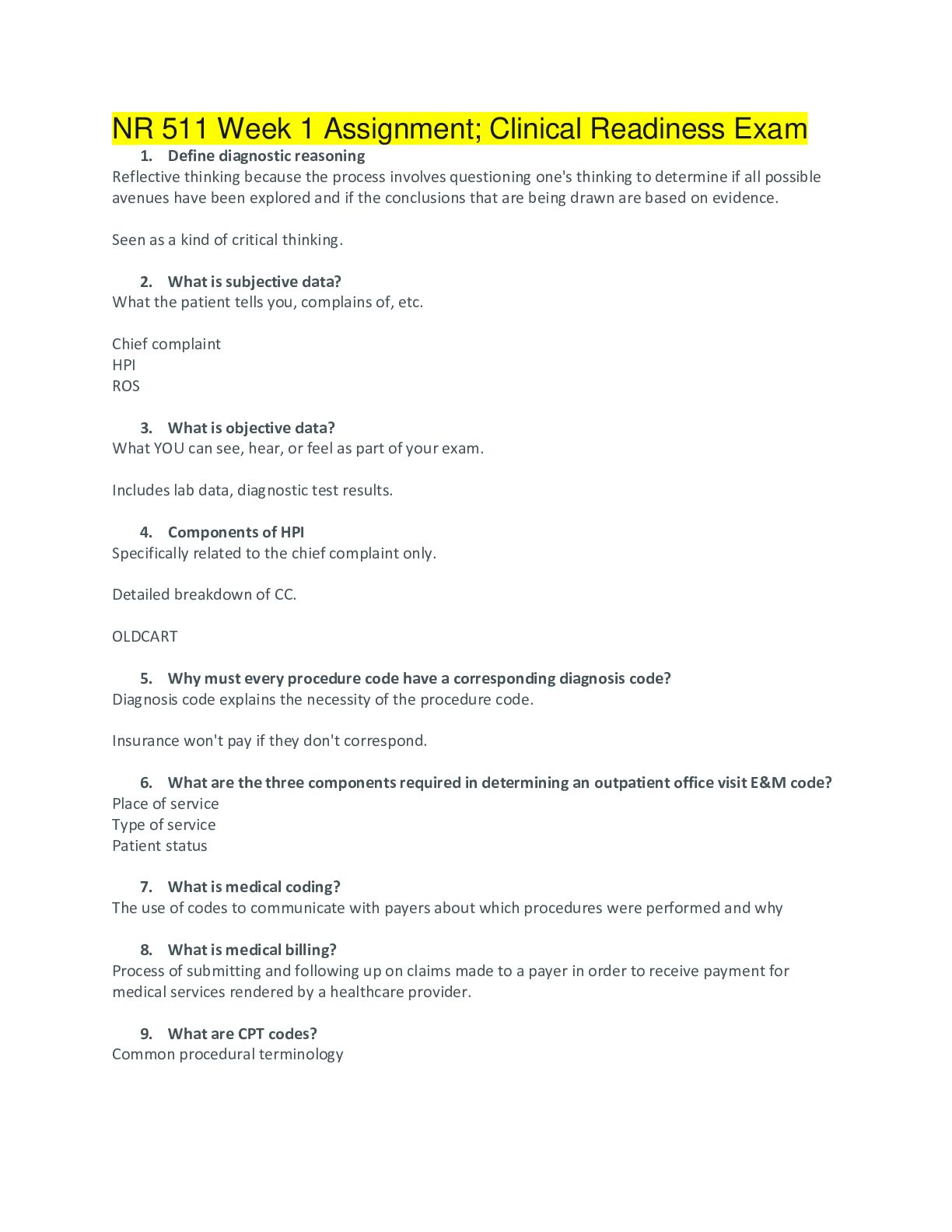NU545 Unit 2 Study blue Questions And Answers Latest Update
Document Content and Description Below
NU 545 Unit 2 Study Blue Questions and Answers; Chapter 14/NU 545 Unit 2 Study Blue Questions and Answers; Chapter 14/NU 545 Unit 2 Study Blue Questions and Answers; Chapter 14 1. T/F Chemical synapse... s between neurons can send messages in both directions 2. T/F Lumbar punctures are performed at the level of L1-L2 because the spinal cord ends just above the L1 vertebrae 3. T/F Microglia perform phagocytosis in the CNS 4. T/F The spinal cord has no direct blood supply and receives its nutrition from CSF 5. T/F The blood-brain barrier is composed of the three meninges covering the brain 6. T/F The fight or flight response is primarily mediated by the parasympathetic nervous system 7. T/F Cholinergic effects increase heart rate, increase contractility, and cause release of renin from the kidneys. 8. T/F The parasympathetic nervous system functions to conserve and restore energy. 9. T/F Most of the blood vessels involved in the control of blood pressure are innervated by sympathetic nerves. 10. T/F Principal cellular changes associated with aging include lipofuscin deposition as well as the presence of neurofibrillary tangles and senile plaques 11. _____ pathways carry sensory information toward the CNS 12. Which of the following transmit a nerve impulse at the highest rate? 13. Which nerves are capable of regeneration? 14. Where is the neurotransmitter norepinephrine secreted? 15. What do oligodendroglia and Schwann cells have in common? 16. During a synapse, what change occurs after the neurotransmitter binds to the receptor? 17. The _____ is a large network of neurons within the brainstem that is essential for maintaining wakefulness. 18. Elaboration of thought and goal oriented behavior are function of the ___ area of the brain. 19. Where is the region responsible for motor aspects of speech? 20. Parkinson and Huntington diseases are associated with defects in the _____. 21. The _____ has two main function: maintenance of a constant internal environment and implementation of behavioral patterns. 22. The ability of the eyes to track moving objects through a visual field is primarily a function of the ____ colliculi.. 23. What parts of the brain mediate the expression of affect, both emotional and behavioral states? 24. The ____ controls reflex activities concerned with heart rate, blood pressure, respirations, sneezing, swallowing, and coughing. 25. From which part of the midbrain do cranial nerves V - VIII emerge? 26. From which part of the midbrain do cranial nerves IX - XII emerge? 27. The ____ is responsible for conscious and unconscious muscle synergy and maintaining balance and posture. 28. What is a characteristic of upper motor neurons? 29. The ____ is the membrane that separates the cerebellum from the cerebrum. 30. What is the function of arachnoid villi? 31. What produces CSF? 32. Which of the following meninges closely adhere to the surface of the brain and spinal cord and follow sulci and fissures? 33. Which cranial nerve contain parasympathetic nerves? 34. What is the primary response from norepinephrine? 35. What is an effect of the sympathetic nervous system? 36. The brain receives approximately ___ % of the cardiac output. 37. The ____ provides for collateral blood flow to the brain. 38. Matching: Receives sensory input from the body 39. Matching: Primary auditory cortex. 40. Matching: Primary visual cortex. 41. Matching: Stimulation of specific areas cause muscles to move. 42. Which Cranial Nerve innervates muscles that move the eye downward and inward? 43. Which Cranial Nerve has motor and sensory function to face, mouth, nose, and eyes? 44. Which Cranial Nerve controls size, shape, and equality of pupils? 45. Which Cranial Nerve causes motor functions to pharynx and salivary glands and sensory functions? 46. Which Cranial Nerve innervates the muscles that move the eye laterally? 47. Which Cranial Nerve carries sensory and motor action to the tongue? 48. Which Cranial Nerve carries impulse for sense of smell? 49. Which Cranial Nerve carries motor and sensory fibers of abdominal organs? 50. Which Cranial Nerve transmits impulses for sense of hearing? 51. Which Cranial Nerve carries sensory and motor fibers to the pharynx and larynx? 52. Which is a function of the somatic nervous system? 53. A neuron with a single dendrite at one end of the cell body and a single axon at the other end of the cell body would be classified as 54. Neurons that carry impulses away from the CNS are called: 55. Neurons are specialized for the conduction of impulses, whereas neuroglia: 56. There is one-way conduction at a synapse because: 57. Which of the following contains the thalamus and hypothalamus? 58. The reticular activating system: 59. Which of the following statements best describes the spinal cord? 60. Which of the following is a protective covering of the CNS? 61. The composition of the cerebrospinal fluid is: 62. An autonomic ganglion can be described as: 63. Clusters of nerve cell bodies and dendrites located within the peripheral nervous system are called: 64. A mass of nerve cell bodies and dendrites located within the central nervous system is a 65. Breathing passageways: 66. Intestines: 67. Liver: MATCHING: Match the structure with the most appropriate function/description 68. Schwann cell: 69. Dendrite: MATCHING: Match the component of a reflex arc with the descriptor 70. Sensory neuron: 71. Effector: MATCHING: Match the function with the cranial nerve 72. Tasting: 73. Balance maintenance: MATCHING: Match the characteristic with the appropriate division of the autonomic nervous system 74. More extensive use of norepinephrine: 75. Effects are more widespread and long-lasting: 76. Elicits energy conservation and restoration: CHAPTER 15 77. T/F Persistent chronic pain produces a physiologic response similar to that of acute pain. 78. T/F: Fever is a normal adaptive response to cytokines. 79. T/F: Temperature regulation is mediated hormonally by the thalamus. 80. T/F: During heat stroke, sweat production on the face is maintained even during dehydration, to cool blood in the cerebral arteries. 81. T/F: Infants have difficulty regulation body heat because they are not as well insulated with subcutaneous fat as are adults. 82. T/F: Fever is a complex, integrated cascade of behavioral, neurologic, and endocrine responses to an exogenous pyrogen. 83. T/F: Heat exhaustion is more serious than heat stroke. 84. T/F: Individuals who recover from heat exhaustion may have permanent damage to the thermoregulatory center. 85. T/F: Phantom pain is more likely to be experienced by people who had pain in the limb before it was amputated. 86. T/F: Depression frequently accompanies acute pain experience. 87. T/F: A person's pain tolerance does not vary significantly over time. 88. T/F: In general, as people age, their pain thresholds decrease. 89. T/F: The nociceptors are at the ends of the large myelinated efferent neurons.) 90. T/F: The fingers are more sensitive to pain than the back because the fingers have more nociceptors to pain. 91. T/F: A delta fibers transmit sharp, localized pain sensations. 92. T/F:According to the specificity theory, there is a direct relationship between the intensity of pain and the extent of the tissue injury. 93. T/F: The gate theory of pain control states that a "closed gate" increases pain perception. 94. T/F: All endorphins act by attaching to opiate receptors on the plasma membrane of afferent neurons. 95. Pricking one's finger with a needle would cause minimal pain, whereas cutting one's finger with a knife would produce more pain. This is an example of the ___ theory of pain. 96. Which type of nerve fibers transmit pain impulses? 97. Where do primary afferent pain fibers enter the spinal cord? 98. Where is the gate located that is referred to in the gate control theory of pain? 99. Which spinal tract carries the most nociceptive information? 100. Where is the major relay station of sensory information? 101. Where in the CNS does pain perception occur? 102. Massage therapy relieves pain by stimulating the ___ that closes the pain gate . . . . . . . . . . . . (continued with 471 Questions and Answers) [Show More]
Last updated: 1 year ago
Preview 1 out of 18 pages
Instant download
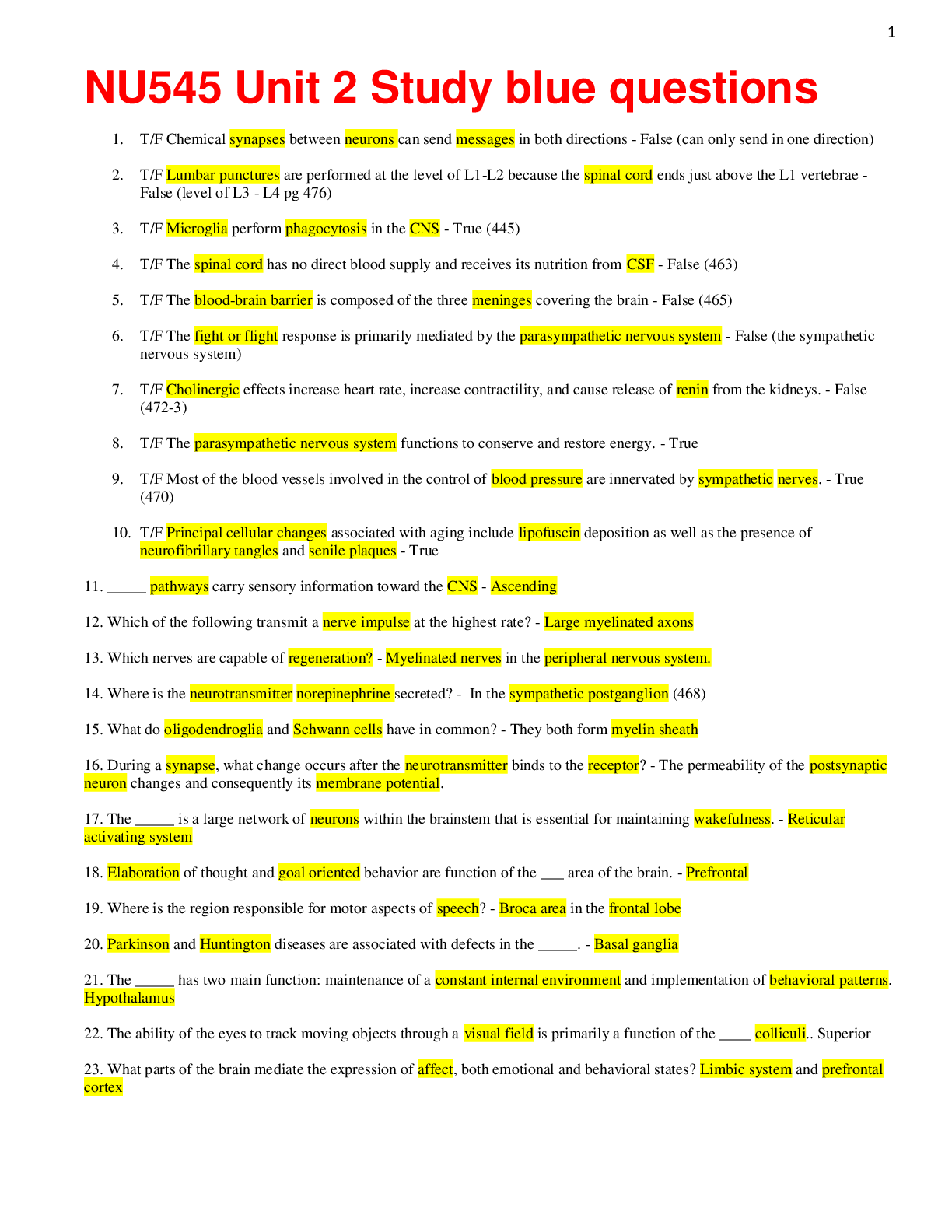
Buy this document to get the full access instantly
Instant Download Access after purchase
Add to cartInstant download
Reviews( 0 )
Document information
Connected school, study & course
About the document
Uploaded On
Sep 03, 2020
Number of pages
18
Written in
Additional information
This document has been written for:
Uploaded
Sep 03, 2020
Downloads
0
Views
61





.png)


